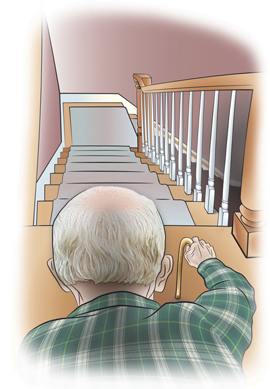
A Slippery Slope for Seniors
Life is full of trips and tumbles. From the time we take our first steps, we all experience tripping over our own two feet now and then. But for seniors, falling is serious and often even deadly. Falling-related injuries are one of the leading causes of death in those over 65. Over 70% of falls occur at home. The good news is that most falls are preventable. Know the risks and how to reduce them, and you can help keep your loved one walking steady.
Factors That Raise the Risk for Falls
Seniors are at a higher risk for taking serious falls, but the risk is even greater if they suffer from:
- Balance and/or cognitive impairment
- Decreased mobility and strength
- Cardiovascular disease
- Neurological disease
- Incontinence
- Vision problems
Pills Can Cause Spills
Medication is one of the most common contributors to falls for seniors. A combination of drugs or mixing drugs with alcohol (or alcohol on its own) can also cause dizziness and falling. High blood pressure meds, sleep aids, antidepressants, and tranquilizers can contribute to falls. Click here for a more extensive list.
The Safest Step is Prevention
Think ahead and assess your senior's surroundings. Do everything you can to avoid a fall and the downward spiral that can follow.
- Light the way.
- Clear the path of clutter.
- Throw out the throw rugs.
- Secure all electrical wiring and cords.
- Buy non-skid shoes.
- Put grab bars near toilet and tub and non-skid mats or strips in tub.
- Avoid ice and wet pavement.
- Screen for vision problems.
- Increase balance through exercise.
- Watch for medication side effects.
- Take it slow.
It's a Pressing Need: A Personal Emergency Response System
You can take all the right steps and still, accidents happen. If your loved one does fall, a personal emergency response system or PERS can be the difference between life and death. The senior wears the small device as a necklace or bracelet. This transmitter has a button that when pressed will alert emergency response and send the address where the call is coming from. A PERS only works at home, so if your senior is active, a cell phone and/or a personalized medical alert bracelet is a good idea. A phone number imprinted on the bracelet gives access to the wearer's detailed information and medical history if a medical emergency occurs.
Click here for a checklist for shopping for a PERS.
Stay on Your Toes to Keep Them on Their Feet
Always be on the lookout for new things that might trip up your senior, from a dropped toy to a frayed rug, or ice on the walkway to water spilled from the dog's dish. Your diligence can make all the difference.
 To obtain additional copies of this free brochure, order from the Web site: The Calm Before the Storm: Family Conversations about Disaster Planning, Caregiving, Alzheimer's Disease and Dementia. Published by The Hartford.
To obtain additional copies of this free brochure, order from the Web site: The Calm Before the Storm: Family Conversations about Disaster Planning, Caregiving, Alzheimer's Disease and Dementia. Published by The Hartford.
 For more information on helping your family prepare for—and more safely and confidently deal with—natural disaters, visit: It Could Happen to Me: Family Conversations about Disaster Planning. Published by The Hartford.
For more information on helping your family prepare for—and more safely and confidently deal with—natural disaters, visit: It Could Happen to Me: Family Conversations about Disaster Planning. Published by The Hartford.